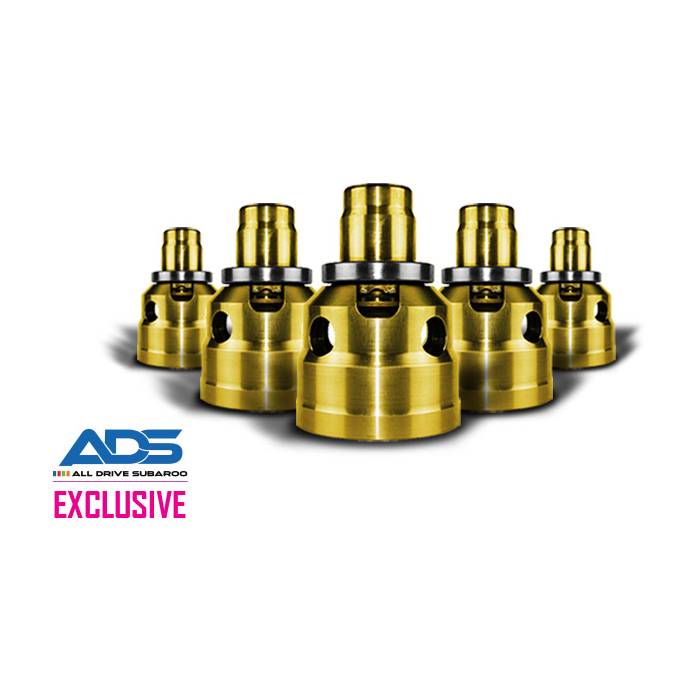We use cookies to make your experience better. To comply with the new e-Privacy directive, we need to ask for your consent to set the cookies. Learn more.
Remanufactured 12kg and 20kg Center Differential by All Drive Subaru
All Drive Subaru now has Remanufactured 5MT center differentials as an option. These starting differentials are used, but they are fully gone through and reconditiond in the process of increasing the rate that the differential will lock up.
This gives you the same performance benefits as the new differentials that All Drive Subaru has to offer but at a much lower cost!
From 1999 up to 2014, the Subaru 5MT used a viscous center differential to transfer power between the front and rear wheels. The stock differential has a rather mild rate at which it can respond to wheel slip, and send power to the front or the rear depending on conditions (4kg of force per 100 rpm of wheel speed difference).
For Rally or Motorsport applications, there used to be a 20kg center differential available from Subaru, but those have gone out of production. Thankfully, All Drive Subaroo (ADS) has figured out a way to produce them in house! If you have been looking for a 20kg center diff for your Rally Car, you are now in luck once again!
These differentials are for the 5-Speed manual transmission used in the 2002 - 2014 WRX, 2004 - 2008 Forester XT, 2005 - 2009 Legacy GT, and 2005 - 2009 Outback XT.
The unique principles governing the viscous coupling
The essential character of the Subaru is in its unique symmetrical All Wheel Drive (AWD) system. With its flat boxer engine set back over the front wheels, Subaru have achieved a 50-50 weight distribution, the same balance as a Formula 1 race car. Combine that with power being distributed to all four wheels, and the ability to vary torque output from front to rear and back to compensate for wheel spin, and you have just about the most poised and satisfying production car on the road, below $100,000.
Literally at the center of the AWD system is the viscous coupling, a compact device fitted to the rear of the gearbox in all manual AWD Subarus. A viscous coupling in the simplest terms is a device for transferring torque from a spinning transmission shaft to the front and rear differentials of your Subaru. It serves also to vary the torque between front and rear wheels, depending on driving conditions. Basically the viscous coupling is a sealed steel cylinder containing a number of slotted disks immersed in highly viscous liquid silicon. Power is transferred from the input shaft via the silicon fluid and disks to the output shafts front and rear. When front or rear wheels spin under power, say, on a wet road, the corresponding output shaft will spin faster, generating more heat at its end, which causes the silicon to solidify and prevent torque from being transferred to the spinning wheels. By default, power is redirected proportionately to the other two drive wheels. The silicon is very sensitive to temperature and reliquefies almost instantly once the temperature drops. The system works so well that the driver is usually unaware of it.
False assumptions about the viscous coupling
Given the power produced by turbo charged engines in Subarus like the WRX, STI, and Liberty GT, its clear that this relatively small component has to work very hard, and it seems unsurprising that there have been a high number of viscous failures over the years, sometimes at quite low kilometres. Its easy to conclude that the viscous coupling must be a weak link in the AWD chain. But that would be a wrong conclusion. Power is not the culprit. In fact there are more failures of viscous couplings in non-turbo models and they are caused by surprisingly minor things, like inconsistencies in tyre sizes and characteristics, extreme off road use, incorrect drive line ratios and poor repair methods.
Imagine for a moment that you fitted 12" wheels to the front of your Subaru and 28" wheels to the rear. Its easy to see that the smaller front wheels would rotate much faster that the large rear wheels, with corresponding speed differences in the shafts leading into the viscous. The viscous coupling would of course get hot at the fast-spinning front shaft, and remain cool at the rear shaft. This extreme example would see your AWD Subaru turned into a rear drive only Subaru. It would also mean the viscous coupling constantly overheating, which would lead to a collapse in the viscosity of the silicon and failure of the viscous coupling. In real life of course you wouldnt have such a large variation in wheel sizes--but, significant variations in front and rear tyre pressures, or different tyre brands and diameters, or significant wear differences front to rear, could all lead to the viscous running too hot and to premature failure. Even running the compact spare wheel too long can cause damage. If your Subaru is properly serviced and maintained, and you run the same size and brand of tyres front and rear, keep the pressures even, and rotate the wheels at the correct intervals, the viscous coupling should last for many years without giving any trouble.
Another problem associated with the viscous coupling is the difficulty of accurate diagnosis. A faulty viscous coupling might produce a range of symptoms, such as shuddering in turns, or what sounds like bearing noise, and these are often misinterpreted, even by experienced mechanics. A customer might pay for replacement of items such as the tail shaft, power steering pump, steering rack, one or more wheel bearings, the rear differential assembly and even the gearbox assembly, without fixing the initial problem. The viscous coupling is often the last component to fall under suspicion.
Owners and repairers sometimes think they might fix a problem with a binding viscous coupling by changing the gearbox oil, or putting in additives. Unfortunately, while the viscous coupling does run in the gearbox oil, the problem is either with the liquid silicon or the case hardening inside the coupling shell. These are entirely separate from the gearbox oil.
Common symptoms reported by Subaru owners with faulty viscous coupling
Customers often report mysterious symptoms that prove to be problems with the viscous coupling. Because this component is hidden and works in the background owners are often baffled by the symptoms, which sound like they could be coming from one or more of several drive line components. Sometimes customers waste money on unnecessary repairs, One customer noticed a clunking sound while parking his Subaru Forester at low speed, and consulted several people to find out what the problem was. His local workshop was not able to diagnose the problem, but another Forester owner in an internet chat room suggested it might be the viscous coupling, which proved to be the case.
Another customer reported a more alarming symptom, chattering in the front wheels while turning, felt through the steering wheel. The customer suspected the front CV joints and replaced them along with the axles. No change. The problem was worse when cornering under power, but still present when coasting though a turn. The customer suspected a range of other components, before bringing the car to us, where we diagnosed a faulty viscous coupling. Many owners dont consider this part as it is hidden, does its work quietly in the background, and when failing produces symptoms that seem to implicate other drive line components.
Another customer complained of a whirring noise that seemed to run throughout the car. This noise was present both under power, and on a trailing throttle and was louder at higher speeds. Because the location of the noise could not be isolated the customer was baffled. The customer was advised by one workshop that it was a wheel, bearing, which he had them replace. This did not fix the problem. We were able to diagnose a faulty viscous coupling bearing plus input and output shaft bearings.
[ NOTE ] * The Reman diffs do not come with a bearing. You can purchase them here. *
https://www.flatironstuning.com/subaru-oem-center-differential-bearing-02-14-wrx-05-09-lgt
WARNING: Operating, servicing and maintaining a passenger vehicle or off-road vehicle can expose you to chemicals including engine exhaust, carbon monoxide, phthalates, and lead, which are known to the State of California to cause cancer and birth defects or other reproductive harm. To minimize exposure, avoid breathing exhaust, do not idle the engine except as necessary, service your vehicle in a well-ventilated area and wear gloves or wash your hands frequently when servicing your vehicle. For more information go to https://www.P65Warnings.ca.gov/passenger-vehicle.
| SKU | ADS-5MT-REMAN |
|---|---|
| Brand | All Drive Subaroo |



